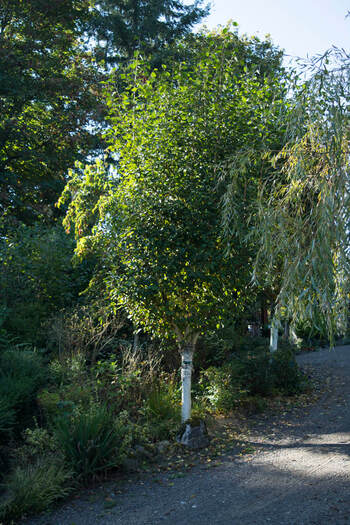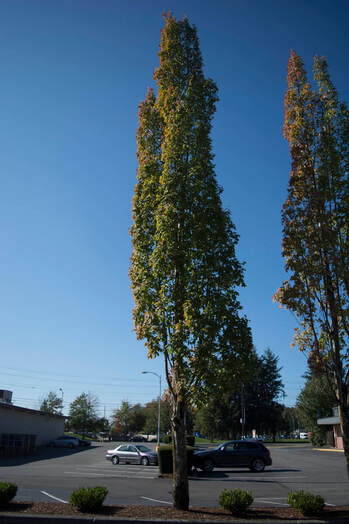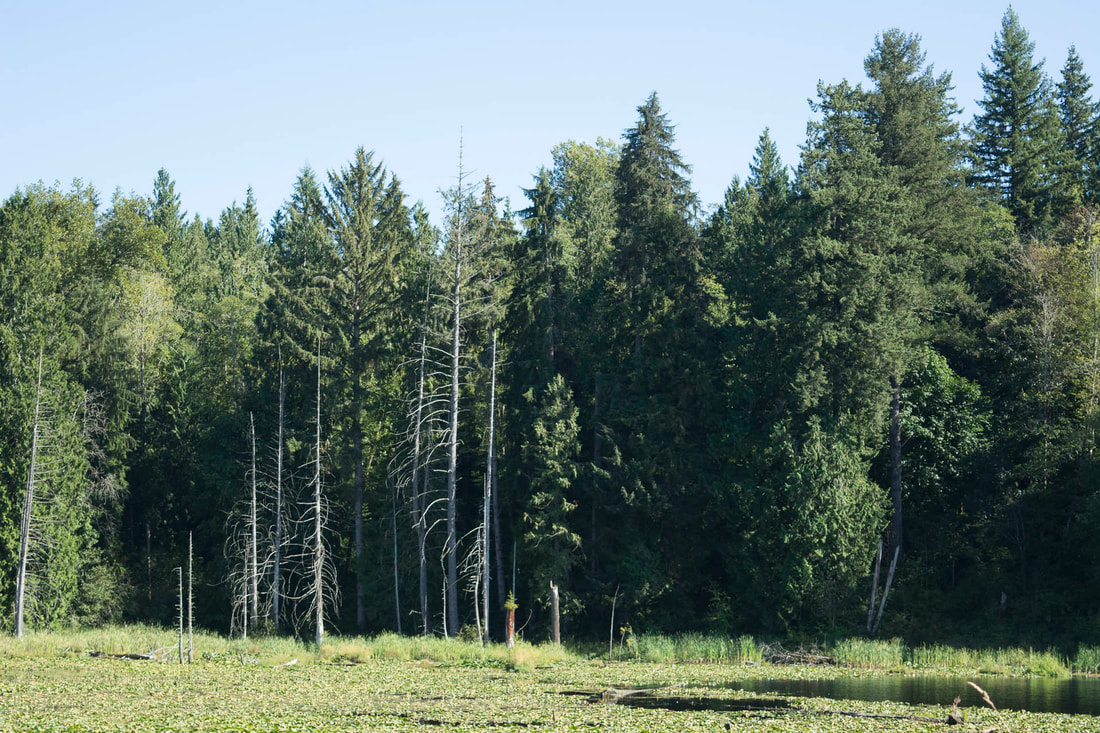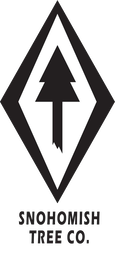|
In this post we will look at the Norway Spruce, Ponderosa Pine, Lodgepole Pine/Shorepine, Paper Birch, Cottonwood, and Douglas Maple. Our previous post in this series covered the Douglas Fir, Western Hemlock, Western Red Cedar, Sitka Spruce, Bigleaf Maple, Red Alder. You can see them all in one spot in our Tree Library page. Norway Spruce The Norway spruce is a Christmas tree shaped conifer that grows up to 180’ tall. Its needles are bluish green like the Sitka spruce, but telling the two apart is not hard: the Sitka has sharp needles that are uncomfortable to touch, and the Norway has shorter needles (not longer than 1”). Both trees have branches that extend at an upward angle, although they may begin to curve downward under their own weight in larger trees. Another feature that sets the Norway apart is that its twigs hang vertically from the branch. This feature can help you confidently ID a Norway spruce, in addition to bluish green needles, and an excessively sappy trunk. Finally, as with most conifers, the most certain way to ID the Norway is by the cone, which is quite large (about 5” long). Ponderosa PineThe Ponderosa pine grows all over Western Washington, from sea level up to ~9000 ft. It commonly grows in dense stands, reaching 200’ tall. In size and shape, it is similar to the Lodgepole pine. Since the two species of pine seem to prefer similar climates, they are easily confused. The needles have the same shape and grow in clusters in both species. The cones are also similar. The best way to ID a Ponderosa is by the orange-brown bark, which grows in large scales that are separated by black cracks. You’ll also find that the needles of the Ponderosa grow up to 8” long, while the needles of the Lodgepole reach only about 3”. Lodgepole pine/ShorepineThe Lodgepole and Shorepine are two sub species of the same tree. In coastal areas, the Pinus contorta takes on a twisted shape. You can confirm a twisted pine by its bark, needles, and cones. The Lodgepole can grow straight and narrow, like the Ponderosa, up to a height of 160’. The appearance of the needles, crown, and cone is similar, making it easy to confuse the two. Note that the length of the needles is much shorter for the Lodgepole (3” max) than that Ponderosa (8” max). Another dead give way is the color and texture of the bark. Paper Birch The paper birch is a slender deciduous tree that can grow up to 130’ tall, but is more commonly found growing to a height of 66’ or less. The trunk grows straight with only small branches extending off it. The most interesting characteristic of the Paper birch is the bark, from which it gets its name. In trees younger than 5 years, the bark is a brown red color. In mature trees, the bark is a bright white that tends to peel off in paper-like sheafs, marked with horizontal dark-brown streaks. The bark is highly water resistant, because of its oil content. The Paper birch prefers wet climates, and retains a lot of water. In dead and fallen trees, the trunk can rot completely before the bark begins to decay, leaving an intact shell. Note that the appearance of the bark in mature trees is roughly similar to the bark in young specimen of the very common cottonwood, but a comparison of the two shows that the bark of the Paper birch is smoother and a of much brighter white color. Cottonwood The cottonwood is extremely common in the Snohomish area, as it prefers wet terrain. Stands of cottonwoods grow along rivers, lakes and ponds, but in areas with plenty of moisture, they can be found almost everywhere. The cottonwood is one of the more hazardous trees to have in your yard, as its branches and/or trunk are easily broken under the force of high winds, or saturated and heavy wood. The roots grow aggressively and have been known to break underground pipes. You can easily distinguish the cottonwood by looking for one of several features. The cotton it produces in spring is the most obvious one. A look at the bark, in larger trees, will show long, vertical strips. These strips are quite thick with crevices in between. The color is gray brown and the bark is extremely hard (enough to create sparks when being cut with a chainsaw). Additionally, the cottonwood is tall (up to 100’) with a canopy that doesn’t extend far, giving the overall tree a tall, narrow shape. Shoots grow vertically off the trunk, throughout the entire trunk. Its these shoots that attract herbivores like rabbit and deer. Douglas Maple The Douglas maple is similar in shape to the Bigleaf maple, but on a much smaller scale. It grows no more than 30’ tall, and is quite slender. This makes its a good choice for parking lot medians and sidewalk garden beds. The leaves are similar to those of the Bigleaf, but they grow no larger than 4”, where those of the Bigleaf maple grow up to 12”. You can make certain that you’re not looking at a young Bigleaf by finding the signature serrated edge of the Douglas maple leaf. You’ll also notice that the Douglas leaf has only 3 full lobes, while in the Bigleaf, there are 5 lobes of roughly equal size. |
SNOHOMISH TREE COMPANYFollow our blog for industry insights, company updates, and tips for working with trees. Archives
February 2022
Categories |


 RSS Feed
RSS Feed
